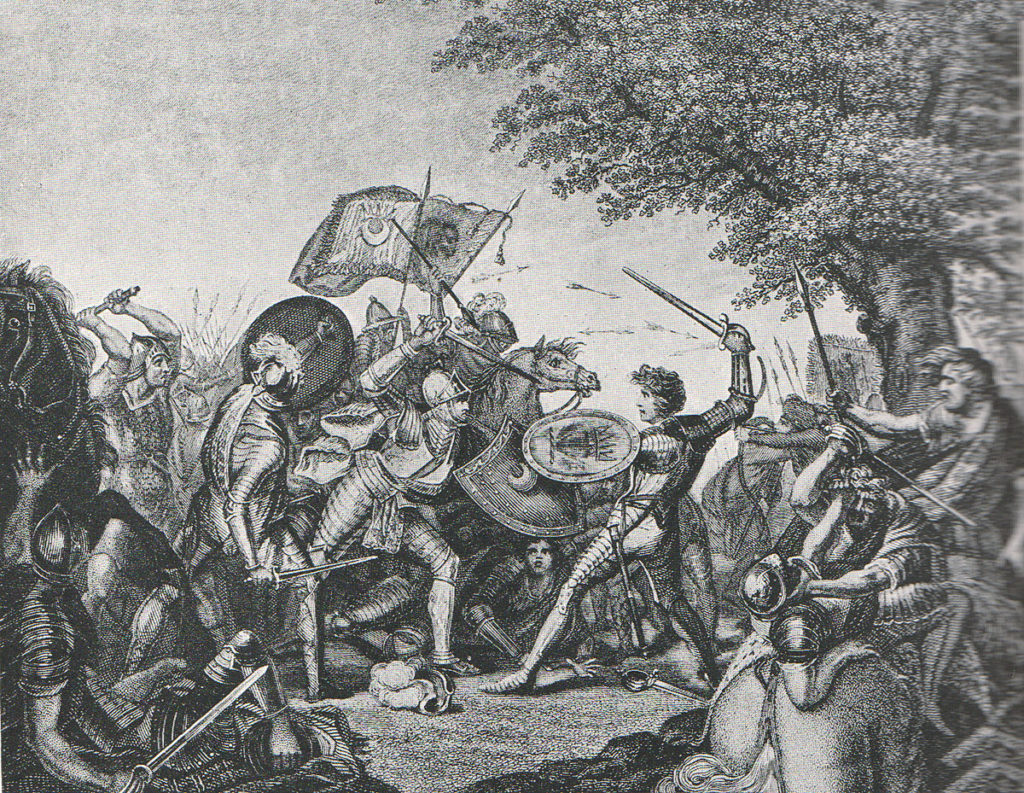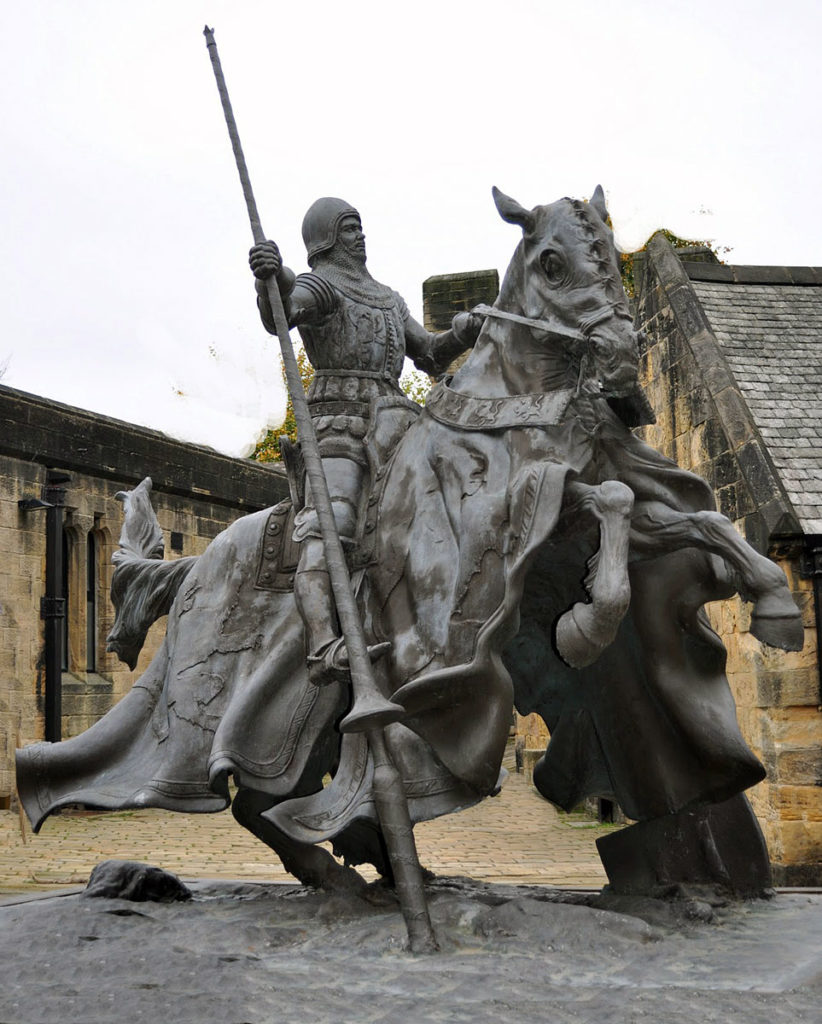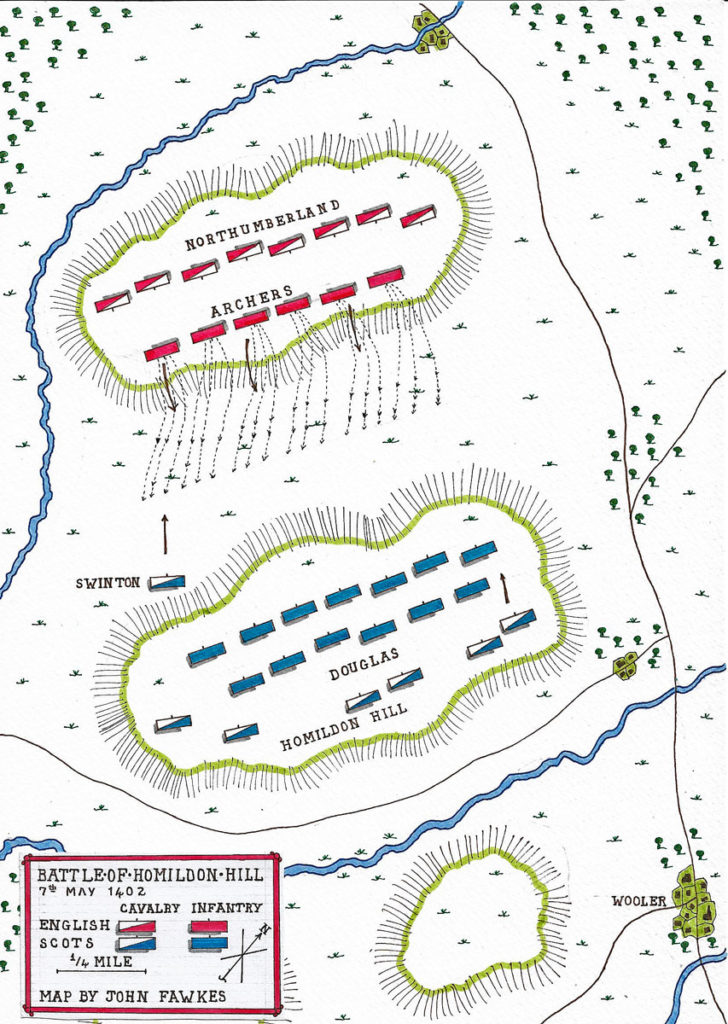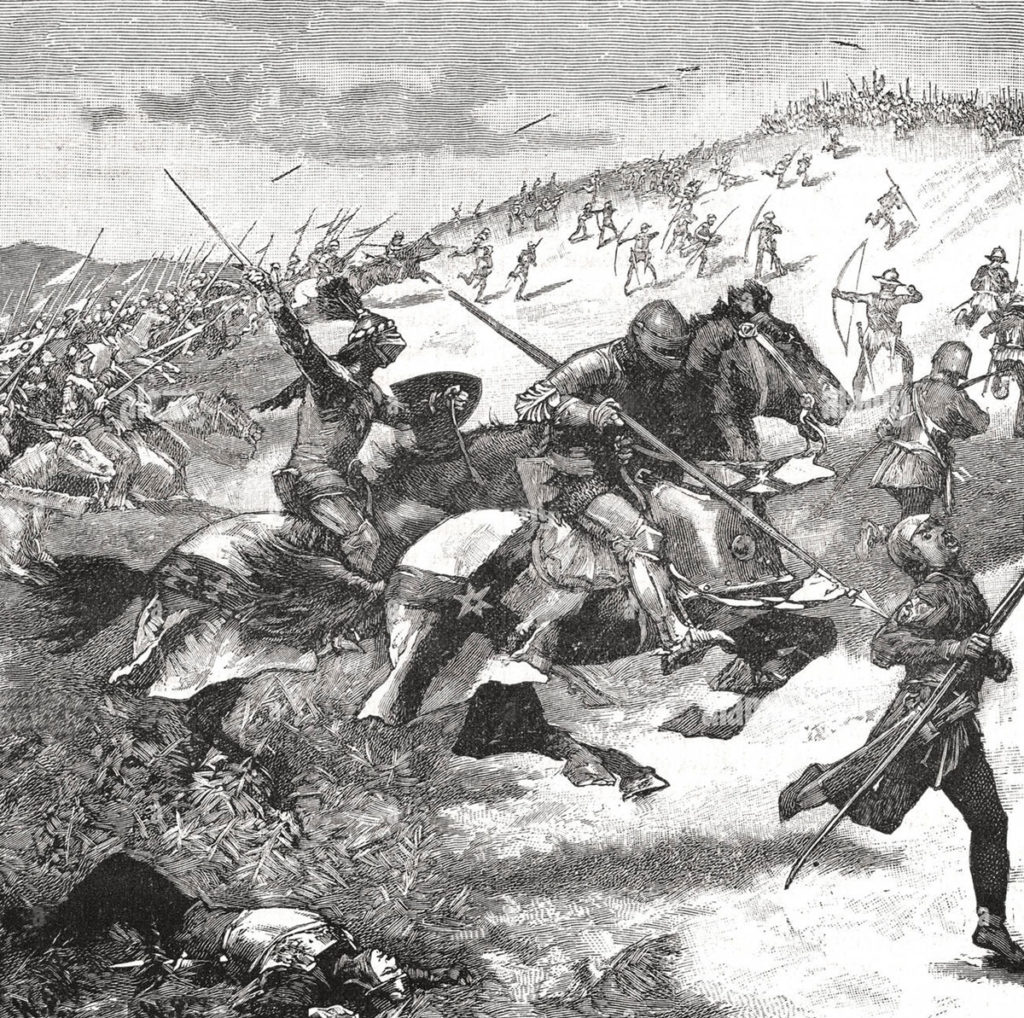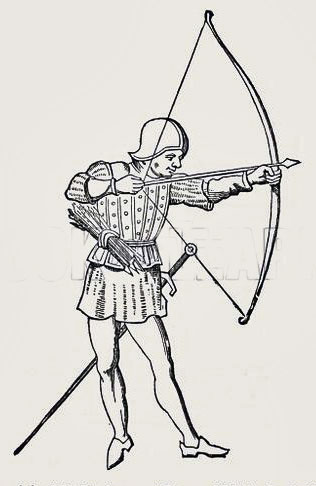The border battle on 7th May 1402 in which the Scots lost a generation of chiefs to the English archers
The previous battle of the Hundred Years War is the Battle of Otterburn
The next battle of the Hundred Years War is the Battle of Shrewsbury
War: Hundred Years War.
Date of the Battle of Homildon Hill: 7th May 1402
Place of the Battle of Homildon Hill: at
Wooler in Northumberland near the Scottish border.
Combatants at the Battle of Homildon Hill: An English army against a Scots army.
Commanders at the Battle of Homildon Hill: The Earl of Northumberland with his son Henry ‘Hotspur’ Percy led the English army. Archibald, Fourth Earl of Douglas led the Scots army.
Size of the armies at the Battle of Homildon Hill: It is said that the Earl of Douglas invaded England with an army of 10,000 men and was accompanied by Murdoch Stuart, eldest son of the Duke of Albany, the Earls of Moray and Angus, Fergus Macdowal, Lord of Galloway, who brought the clans from the Southern Highlands.
The English army, smaller than the Scots army but probably not significantly so, was raised almost entirely from the northern counties of England, King Henry IV being immersed in dealing with the revolt in Wales of Owen Glendower.
Uniforms, arms and equipment at the Battle of Homildon Hill: Knights increasingly wore steel plate armour with visored helmets. Their weapons were lance, shield, sword, various forms of mace or club and dagger. Many carried two-handed swords in battle. Each knight wore his coat of arms on his surcoat and shield.
English archers carried a powerful bow.
For hand-to-hand combat archers carried swords, daggers, hatchets and war hammers. They wore jackets and loose hose. Archers’ headgear was a skull cap either of boiled leather or wickerwork ribbed with a steel frame.
The Scottish infantry were largely armed with spears and whatever cutting or striking implements were available to them. Some were armed with short bows, not the longbows carried by English and Welsh archers.
Winner of the Battle of Homildon Hill: A decisive victory for the English.
Account of the Battle of Homildon Hill: Throughout the Hundred Years War Scotland fought against England in alliance with France under the ‘Auld Alliance’.
In 1402, King Henry IV of England faced a dangerous revolt in Wales led by the Welsh leader Owen Glendower.
With the encouragement of the King of France, the Scots took advantage of the English King’s absence in Wales to invade England.
Archibald, the fourth Earl of Douglas, assembled a Scots army of some 10,000 men and invaded Northumberland, partly in revenge for the Scots defeat at the Battle of Nesbit Moor earlier in the year.
The English response was led by the Earl of Northumberland and his son Henry ‘Hotspur’ Percy, assisted by the renegade Scots nobleman George Dunbar, Earl of March, an able and experienced soldier.
The Scots army laid waste to the Northumberland countryside to the gates of Newcastle.
The Earl of Northumberland assembled a strong army and adopted the tactics used previously against marauding Scots armies of intercepting the Scots on their march home, when they were laden with loot and their discipline lax.
The Scots army reached Wooler where Douglas received the information that Northumberland with his English army was barring his route to Scotland and advancing towards him.
The Scots army halted in a range of low hills and took up a position on one named Homildon Hill.
The Scots adopted their now traditional formation of closely packed ranks of infantry.
The English army assembled for battle on the hill immediately to the front of Homildon Hill.
Although the English army was less numerous than the Scots, Hotspur intended to launch an immediate attack on the Scots line.
Hotspur was restrained by the more experienced Dunbar who urged him to permit the English archers to discharge their arrows at the Scots before Hotspur led his charge across the valley.
Hotspur agreed and the English archers filed to the front of the English line and began a rain of arrows on the Scots formation.
The English archers poured in their volleys ‘thick as hail upon their foes, whose ranks were so closely wedged together that a breath of air could scarcely penetrate their files, making it impossible for them to wield their weapons. The Scottish pikemen, most of whom were clad in light armour, fell in hundreds over each other; and many of their knights, who still adhered to the old-fashioned chain-mail, found it no defence against the deadly English shafts. They fell fast from their horses; and these, wounded, ungovernable, their breasts and flanks bristling with blood-stained arrows, galloped madly to and fro, trampling the dead and the dying together.’
The senior Scots knight, Sir John Swinton, urged a party of men-at-arms to join him in a charge against the English line. He was joined by his long-standing enemy Adam Gordon, whom Swinton is said to have knighted before they set off on the attack.
Swinton’s body of mounted men, numbering 200, were shot down by the English archers before they could reach the English army.
Douglas attempted to lead another charge against the English line, but came to grief in the same way as Swinton.
Once the English archers had discharged their arrows, they attacked the remnants of the Scots army and drove the survivors off the field.
It is said that few of the English knights and men-at-arms positioned behind the line of archers even drew their swords or laid their lances to rest, all the fighting being conducted by the English archers, either with their bows or with their other weapons.
The Scots army was annihilated, many of the Scots soldiers being drowned in the River Tweed in attempting to escape.
Casualties at the Battle of Homildon Hill: It is said that among the Scots taken prisoner by the English were some eighty nobles and knights from Scotland’s leading families. Among the prisoners was the Earl of Douglas, suffering from five wounds including the loss of an eye.
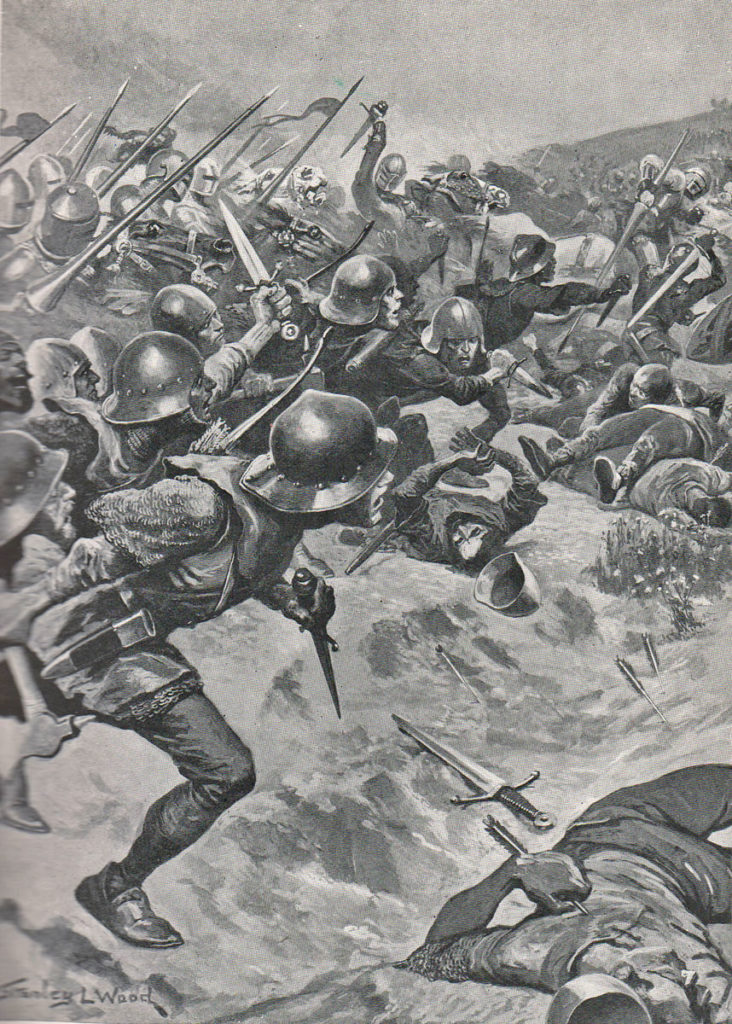
Follow-up to the Battle of Homildon Hill:
The battle ended the threat from Scotland to the north of England for a generation, so many leading Scots nobles being killed or captured.
King Henry IV refused to permit the Scots prisoners to be ransomed, leading Hotspur to rebel later in the year.
Anecdotes and traditions from the Battle of Homildon Hill:
- Grant states: ‘More than ever did the result of 7th May prove that the flower of England’s feudal infantry were her archers. Made either from yew, ash, hazel, or elm, the bow was put into the hands of every English boy at the age of seven, and it ceased not to furnish him with sport and occupation till years deprived his arm of strength and his eye of skill; and from the Conquest down to the introduction of the musket, the use of this weapon was enforced by the English legislation.’
- Another author stated: ‘A first-rate English archer who in a single minute was unable to draw and discharge his bow twelve times with a range of 250 yards, and who in these twelve shots once missed his man, was very lightly esteemed.’
References for the Battle of Homildon Hill:
Cursed Kings, Volume IV of the four-volume record of the Hundred Years War by Jonathan Sumption.
The Art of War in the Middle Ages Volume Two by Sir Charles Oman.
British Battles by Grant.
The Hundred Years War by Robin Neillands.
The previous battle of the Hundred Years War is the Battle of Otterburn
The next battle of the Hundred Years War is the Battle of Shrewsbury
